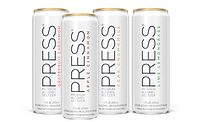Vanilla’s classic taste meets today’s beverage needs
Ingredient suppliers address supply chain concerns

Fashionistas will often say that a simple black dress will never go out of style. In the food and beverage industries, the same can be said for certain flavors. As a staple in product development, vanilla has shown that no matter what the latest fad is, you can’t beat the classics. In Beverage Industry’s New Product Development Outlook 2017 study in the January 2018 issue, respondents selected vanilla as a top-selling flavor of 2017 with 23 percent naming it as such. Additionally, respondents expected vanilla to maintain its appeal into 2018 as 22 percent named vanilla as an anticipated top-selling flavor.
Ingredient suppliers also note how classic flavors still remain valuable to beverage manufacturers despite vanguard trends that might suggest otherwise.
“Vanilla is one of the world’s most popular flavor profiles used in food and drinks,” says Mukul Juneja, vice president of commercial development for Fort Collins, Colo.-based Rodelle/Chicago-based Archer Daniels Midland Co. (ADM). ADM recently acquired Rodelle.
“Many beverage categories have traditionally used vanilla as a leading flavor profile,” he continues. “As consumers continue to demand clean- and clear-label options, brands are responding by using familiar ingredients such as vanilla extract to flavor their products. Additionally, we continue to see interest in highlighting the specific origin of vanilla, for example, Madagascar.”
Meghan Sutton, senior marketing specialist at Philadelphia-based Tastepoint by IFF, also notes the popularity of vanilla as a flavor solution in beverages.
“Vanilla is a perennial flavor choice across a wide selection of applications ranging from dairy to culinary, beverages and truly everything in between,” Sutton says. “Despite consumers’ increasing desire for more flavor variety, the beloved classics are still go-tos. Vanilla is the top flavor in beverages, especially in meal replacement/protein, coffee and dairy — and simply cannot be ignored.
“Within the past year, there were over 130 new beverage launches touting a vanilla flavor, according to Mintel’s Global Product Database,” she continues. “Seventy-two of those new launches were in the meal replacement or protein beverage categories. Given consumers’ recent embrace of plant-based diets, there’s been a huge uptick in new plant-based protein beverage launches, and vanilla is a top flavor being launched in this category as well.”
Ed McIntosh, marketing manager of Downers Grove, Ill.-based Flavorchem Corp., echoes similar points. “Vanilla is the world's most popular flavor and combined with the ever-growing health-and-wellness trends, you will see more vanilla used as a masking agent especially for plant proteins as well as a stand-alone flavor,” he says.
Referencing customer requests as well as Chicago-based Mintel data, McIntosh notes that the following beverage categories are the top ones that feature vanilla usage: meal replacements, coffee, wine, ready-to-drink iced coffee, beer, malt and other hot beverages, tea, beverage concentrates, carbonated soft drinks and spirits — particularly vodka and whiskey.
Tastepoint’s Sutton adds that vanilla’s characteristics make it ideal for creamy-based beverages. “We see protein beverages, dairy beverages and coffee utilizing vanilla most frequently in the beverage world,” she says. “Vanilla pairs really well with the creamy, fatty notes of dairy, and is a perfect complement to bitter, complex coffee. It’s also a great flavor to mask unfavorable tastes in protein beverages.”
Philip Caputo, marketing and consumer insights manager for Brooklyn, N.Y.-based Virginia Dare, highlights how vanilla’s flavor profile complements today’s beverage trends.
“Vanilla’s ability to enhance the profile of clean-label beverages is [a] notable observation,” he says. “Vanilla naturally carries a perceived sweet taste, smoothing effect and subtle creaminess that can improve the taste of low or no sugar formulations, sparkling beverages, and plant-based protein drinks. For example, consider delivering a satisfying all-natural, sugar-free sparkling beverage. We choose delicate blends of white tea and jasmine to contrast with the carbonation, then add a vanilla top note for a hint of sweetness, depth, and added mouthfeel. Vanilla not only enhances the tea and jasmine, but rounds out the profile in absence of sugar.
“Building on these inherent enhancing attributes, Virginia Dare has developed natural vanilla masking FMPs (flavors with modifying properties) specifically for plant protein drinks,” he continues. “These FMPs mask bitterness, improve texture and provide vanilla flavor with the aforementioned enhancing qualities.”
A versatile solution
Although vanilla-flavored products have solidified their place in the beverage market, vanilla also harnesses strong usage as a complementary flavor.
“Because of its popularity and versatility, vanilla will always be used as a stand-alone flavor but also in combination with other flavors,” Flavorchem’s McIntosh says. “Further, vanilla is used to round out fruit flavors, mask offnotes and add complexity to beverage systems.”
Wayne Lewis, flavorist 1 at Tastepoint, also speaks to vanilla’s versatility in beverage formulation.
“Vanilla is often used to complement and enhance many popular flavor tonalities such as chocolate, caramel, and even fruit,” he says. “However, vanilla on its own is still one of the most popular flavor profiles in the world.”
ADM’s Juneja explains that because of vanilla’s versatility, it can expand the range of a beverage profile. “Vanilla also provides complexity to a range of flavor profiles but in these cases it does not play a starring role, it provides a great base note that supports another flavor profile,” he says. “Vanilla also plays a great role in taste modification for bitter masking or sweetness enhancement. Due to its versatility, combination possibilities with vanilla are almost endless.”
Also adding to vanilla’s appeal is its ability to fulfill vanguard consumer trends, like clean label.
“Even though the price of vanilla beans has increased significantly in recent years, we continue to see new product launches that highlight vanilla extract as an ingredient — both in North America and globally,” Juneja explains. “The main reason for this is the fact that vanilla extract is one of the most familiar ingredients and is a staple in most U.S. pantries. It fits perfectly with today’s consumer movement to clean and clear labels.
“In addition to the familiarity of vanilla extract, other aspects of the clean-label movement such as organic certification, traceability and sustainability of natural resources are all important to today’s consumers,” he continues. “These expectations are helping reshape how vanilla is grown, extracted and used in applications. Rodelle, now a part of ADM, owns a stake in Federation Sahanala Vanille — a partnership of local associations that now includes more than 2,100 registered vanilla farmers — and is capable of producing industry-leading volumes of certified organic vanilla.”
However, supply chain challenges remain a concern for the vanilla market, and ingredient suppliers are looking to address these concerns.
“The biggest challenge right now when formulating with vanilla extracts is cost,” ADM’s Juneja says. “Due to various reasons, the cost of vanilla beans has increased significantly in recent years. ADM works very closely with our customers to understand their needs.”
Flavorchem also has developed a portfolio with supply chain concerns in mind.
“In response to global vanilla bean shortages, Flavorchem has developed a line of natural WONF vanilla flavors that can substitute a single, double, or higher folds of pure vanilla extract,” McIntosh explains. “These vanilla replacers are excellent performers in beverage applications and provide all the complex notes of a pure vanilla bean extract. They are also available as non-GMO and organic compliant. Of course, we offer traditional vanilla extracts in a variety of folds, forms and types to serve all segments of the beverage market.” BI
Looking for a reprint of this article?
From high-res PDFs to custom plaques, order your copy today!






